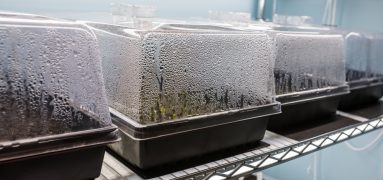What's The Deal With Airflow?

Why plants love airflow and how to get your indoor air moving
Wind is a naturally occurring element that outdoor plants face—but do indoor plants need air movement, too? Growers know that the answer is “yes,” but why and how is airflow so important to plants? Low wind speeds (less than 5 mph) create many benefits for plants and, consequently, growers. Here are some reasons why airflow is good for indoor crops:
Air movement causes better transpiration rates.
Without good airflow, plants can’t respire at sustainable levels. If the air surrounding the plants doesn't move, then it becomes saturated with O2, and the plants are unable to respire at a high enough rate. Constantly having airflow prevents the air from becoming saturated, and the plants can release gases more easily.
Airflow replenishes CO2 levels.
Another problem with stagnant air? Plants will quickly run out of carbon dioxide to take in. Increased ventilation and airflow can help increase CO2 levels and, as a result, increase photosynthesis rates.
Airflow makes plants stronger.
When plants face wind resistance, they grow more supportive stem cells. Exposure to air movement makes plants stronger, healthier, and more resistant to damage.
Airflow is a key component of climate control.
The overall climate within your growing space is largely impacted by ventilation and airflow. Maintaining a good airflow can help regulate the temperature within the space and distribute hot air more evenly. Growers will want to include a ventilation/circulation system within their climate controls system.
Airflow prevents moisture buildup, which could lead to mold.
Utilizing ventilation can help prevent the temperature within the greenhouse from meeting the dew point, which is when condensation occurs and mold/rot becomes a threat.
Plants need airflow to reproduce.
Wind is Earth’s natural pollinator (along with insects, of course). Without wind or insects, indoor growers either have to pollinate by hand or create adequate airflow. Since pollinating by hand is very time-consuming and creating airflow has so many important benefits, ensuring air movement is probably a grower’s best bet.
So how can growers control air movement within indoor growing spaces? Researchers recommend 8 CFM/ft2 (cubic feet per minute for every square foot) for hot seasons and 2 CFM/ft2 for cold seasons. To achieve this, you can utilize:
Vents
Naturally venting air in and out of your indoor grow is the simplest solution. Most greenhouses have vents on the roof or walls, and some even have walls that can be rolled up to let air in. Rolling up the sides or opening a window can provide some much-needed airflow, although it might be hard to maintain a consistent climate with this method. However, it is also the cheapest and most energy-efficient option! Vents can be manually opened or mechanically integrated into your climate controls system.
Fans
Fans are another great option for venting fresh air into your greenhouse, as well as creating air circulation. You can manually control fans, or you can integrate them into your climate controls system.
If you’re not growing in a greenhouse that's easily ventilated, you might have to take your fan and vent strategy a bit further. If you want fresh air to reach your grow room, you’ll have to install some ductwork and exhaust fans to help pump air in and out.
Whichever way you want to make some movement, TC Control Group is here to help. Our engineers and technicians will design and install a fully integrated system that keeps your climate controlled, your air circulating, and your crops happy.



